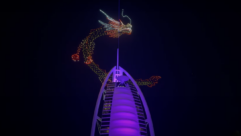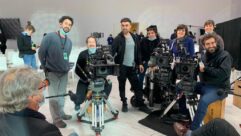Sky Show
May 1, 2002 12:00 PM,
By Aram Friedman
How far would you go for technology that does not exist? In the old days of component electronics and machine code, contractors would pull out the wire wrap and build it themselves. These days, if you’re lucky, you might find a manufacturer with a product similar to what you need. You just have to convince them that it is to their benefit to alter their 5-year plan, divert their best resources and cater to your unique needs — good luck!
The Hayden Planetarium’s Digital Dome needed two years, a dozen manufacturers and $6 million to get to its first public digital sky show on December 31, 1999. It also required every trick and cheat in the book plus brute force in its purest form.
The search for Life: Are we Alone?” premiered in March 2002. Taking audiences from the depths of Earth’s oceans to Jupiter’s giant moons, the show is a simultaneous projection of seven individual movies covering the entire domed ceiling. The Hayden Planetarium boasts the world’s largest virtual reality simulator. The movie’s creators used scientific data to create dazzling images and animations to send audience through space as never before. Three years ago, none of it existed.
- Upgrades Needed. The 430-seat dome is 21 meters in diameter, illuminated by 7 Barco 812 CRT projectors modified by Seos Limited. Originally the images were 3-D simulations generated in real time by an Onyx visualization system from SGI. When the project was first conceived, the only way to attain the resolution needed (1280-by-1024, 60 frames progressive by seven channels) was with real-time simulation generated by the Onyx. But in practice that approach was risky, as the Onyx was working at the edge of its abilities and was prone to drop frames, causing an unacceptable loss of sound sync.
So six months before opening, the Planetarium switched from real-time simulation to hard-disk playback, showing prerendered movies stored in a RAID array.
To get the resolution and bandwidth needed, this setup required 14 Ciprico RAID Arrays feeding the Onyx with data 30 times a second. The Onyx in turn filled its frame buffers, then double printed the image to the dome (60 fps progressive). That approach was only slightly more reliable, but at least the sound was stable. Unfortunately, it still depended on the Onyx, with its expensive maintenance contract and finicky behavior. To make matters worse, the disks were full, leaving little room to store a second production. Creating a new show would necessitate the purchase of more RAIDs, a waste of a valuable resources.
The system barely worked, and it took the efforts of as many as 16 skilled hardware and software engineers working three shifts seven days a week to keep it going. Once the theater was up and running, there was no time to do repairs or upgrades. Everyone’s home phone number was taped to the side of every machine in case of emergencies, and that was standard operating procedure for more than a year.
A NEW DAWN
one sunday in 2001, the Onyx, the $2 million beast that generated the digital movie, finally started to succumb to being run past capacity without a break for so long. It lost several processor boards at the same time — 30 minutes before the first show of the day. The maintenance contract only guaranteed services within four hours. So, having refunded the tickets, the planetarium directors decided to start pushing to build the digital disk recorders that would replace the Onyx.
- Digital Disk Recorders. Unlike a general purpose Unix computer, a DDR has only one set of functions: to record and play digital movies. Better still, they require no expensive maintenance contracts. The spec went only to manufacturers that had already made a commitment to high definition because the product was guaranteed to need some modifications no matter who won the contract. Each of the dome footprints is 4:5 progressive. Additional requirements were RAID redundancy, 4-pair AES audio per unit, a convenient way to restore data and perfect synchronization between channels.
Calibrating the output of the DDRs to the dome was also an issue. Rules for aligning monitors and cameras simply don’t apply to a multichannel dome. Geometry, registration, color balance and edge blending required completely new skills and techniques. It was necessary for the DDRs to have horizontal and vertical positioning; black level, gain and gamma adjustments; and modified sync to be compatible with the edge-blending hardware.
Those requirements frightened off most of the field, leaving only two potential suppliers. Digital Video Systems of Hanover, Germany, was willing to supply a prototype at no charge. As the project manager, I couldn’t commit the large sum of money needed for the project (10 units were needed) without proof of concept. As it turned out, the key to DVS’s success was its proprietary video card. DVS sells the card OEM, so it was designed to be flexible; 4:5 rasterizing and double printing was easy. The demo was successful, and the contract was negotiated.
- To Failsafe a System. A major concern was the ability to restore data to the DDR if a worst-case failure were to occur. Seven DDRs feed the main dome, two feed the Big Bang Theater (the lower half of the Hayden Sphere, which houses a presentation on the Big Bang Theory), and one is used as a spare.
The first layer of protection is the DDR’s RAID capability. The theater can still operate even if one of the 12 internal drives goes down. After show hours a replacement drive can be installed and the missing data automatically reconstructed.
The second layer of protection is termed pseudo-RAID. Each DDR contains the contents of two adjacent dome channels, and the spare DDR contains channels 1 and 7. In the event of a massive failure of any of the first seven DDRs, video can be rerouted from the remaining disks (including the spare). That generally takes approximately 30 minutes to set up.
The third layer of protection exists in the show archive on Sony HDCam videotape. The video data for the 4:5 rasterizing is scaled into a 16:9 1080i format, and the 8 AES channels are loaded into the leftover space and recorded to tape in real time. To restore a show is a simple matter of reversing the process. The 7:1 compression of the Sony HDCam is transparent to the dome. A bonus of that feature is the ability to load new shows quickly, which also allows shows to be distributed to other planetariums.
The fourth and final layer of failsafing is the Sony DTF-II data tape, uncompressed original data for mastering and production. A 30-minute show takes approximately four to six hours to load and is generally used for overnight restoration of the data and long-term archiving.
CREATING THE UNIVERSE
dvs delivered the Big Bang DDRs in May 2001. The first units worked for the most part but not without a bit of pain. A manufacturer often doesn’t have all the resources at its facility to test a system in context, causing the dome to become an alpha test site. The situation was further complicated by the fact that DVS is located in Germany, and communications with the factory happened by e-mail overnight.
One of the tricks the team built into the Big Bang units is the ability to drive two projectors from one DDR, called Mux mode (data multiplexing). Adjacent progressive images are loaded into one interlaced frame (1280-by-2048 at 30fps). When the DDR is configured for Mux mode, its vertical sync carries an additional bit of information that identifies left frame/right frame. A memory mapper from Seos called Mercator reads the pulse, de-interlaces the data and sends it to the proper projector.
The advantage of the Mux trick was to reduce the cost of the DDRs by 50 percent. The only disadvantage is that the data update rate is limited to 30fps progressive (as the output frame rate is still double printed to the projectors). In practice, 30 fps looks fine, and there’s always the option of adding additional DDRs to increase the frame rate.
Mercator’s main function is correcting the image geometry for the domes’ curved surface. The compatibility between the DDRs and Mercator was written into the contracts of both companies. Both agreed in principal to coordinate their efforts. When the first two prototypes arrived, the Planetarium arbitrated between the manufacturers involved in the project, rather than let the companies fruitlessly point fingers at one another. Instead, the system was carefully tested and information was disseminated to all parties involved. That was followed by a conference call in which everyone discussed the issues and agreed on what to do next.
The Big Bang Theater opened using the two prototype DDRs even though all the contracted features were not yet functional (the needed features had been prioritized early in the development process), and three months later, in July 2001, the remaining DDRs for the main dome were delivered.
To guarantee the uninterrupted operation of the theater, the new DDRs were wired into the theater via an RGB video router. A panic button added into the automation could switch the theater back to the Onyx playback if anything went wrong. For the first two days engineers remained present in the dome for all shows. On the second day flickering was observed on one of the dome channels and the panic button was used. It switched to the Onyx with only a slight flash to the dome, and all was well. It took only a few minutes to isolate and correct the problem and put the DDRs back on line for the next show.
From that point on, the Planetarium has run almost exclusively on the DDRs with the Onyx as emergency backup, even though the DDRs were still in development. As new software and upgrades become available, the spare unit can be used for off-line testing. Then the main DDRs are upgraded after the last show of the day, and the universe keeps on turning.
Aram Friedman is the director of engineering at the Rose Center for Earth and Space in the American Museum of Natural History in New York City.
For More Information
Barco
barco.com
□ 220
Digital Video Systems
dvsus.com
Seos
seos.com
□ 223
Sony
sony.com/professional
□ 225
Ciprico
ciprico.com
□ 221
RGB
rgb.com
□ 222
SGI
sgi.com
□ 224
□ = Circle this number on Reader Service Card









